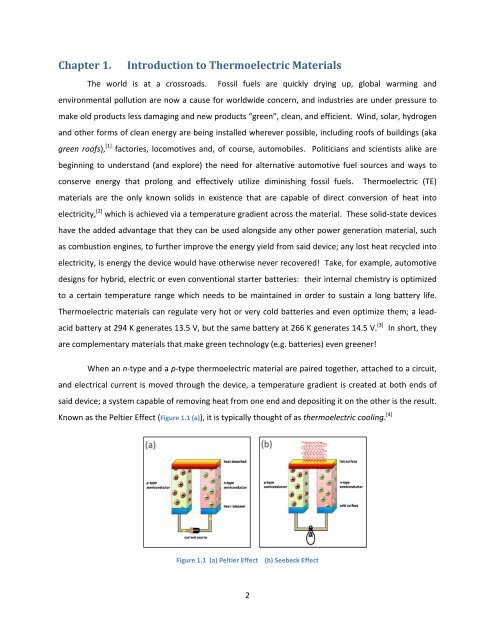Exploration and Optimization of Tellurium‐Based Thermoelectrics
Exploration and Optimization of Tellurium‐Based Thermoelectrics
Exploration and Optimization of Tellurium‐Based Thermoelectrics
Create successful ePaper yourself
Turn your PDF publications into a flip-book with our unique Google optimized e-Paper software.
Chapter 1. Introduction to Thermoelectric Materials<br />
The world is at a crossroads. Fossil fuels are quickly drying up, global warming <strong>and</strong><br />
environmental pollution are now a cause for worldwide concern, <strong>and</strong> industries are under pressure to<br />
make old products less damaging <strong>and</strong> new products “green”, clean, <strong>and</strong> efficient. Wind, solar, hydrogen<br />
<strong>and</strong> other forms <strong>of</strong> clean energy are being installed wherever possible, including ro<strong>of</strong>s <strong>of</strong> buildings (aka<br />
green ro<strong>of</strong>s), [1] factories, locomotives <strong>and</strong>, <strong>of</strong> course, automobiles. Politicians <strong>and</strong> scientists alike are<br />
beginning to underst<strong>and</strong> (<strong>and</strong> explore) the need for alternative automotive fuel sources <strong>and</strong> ways to<br />
conserve energy that prolong <strong>and</strong> effectively utilize diminishing fossil fuels. Thermoelectric (TE)<br />
materials are the only known solids in existence that are capable <strong>of</strong> direct conversion <strong>of</strong> heat into<br />
electricity, [2] which is achieved via a temperature gradient across the material. These solid‐state devices<br />
have the added advantage that they can be used alongside any other power generation material, such<br />
as combustion engines, to further improve the energy yield from said device; any lost heat recycled into<br />
electricity, is energy the device would have otherwise never recovered! Take, for example, automotive<br />
designs for hybrid, electric or even conventional starter batteries: their internal chemistry is optimized<br />
to a certain temperature range which needs to be maintained in order to sustain a long battery life.<br />
Thermoelectric materials can regulate very hot or very cold batteries <strong>and</strong> even optimize them; a lead‐<br />
acid battery at 294 K generates 13.5 V, but the same battery at 266 K generates 14.5 V. [3] In short, they<br />
are complementary materials that make green technology (e.g. batteries) even greener!<br />
When an n‐type <strong>and</strong> a p‐type thermoelectric material are paired together, attached to a circuit,<br />
<strong>and</strong> electrical current is moved through the device, a temperature gradient is created at both ends <strong>of</strong><br />
said device; a system capable <strong>of</strong> removing heat from one end <strong>and</strong> depositing it on the other is the result.<br />
Known as the Peltier Effect (Figure 1.1 (a)), it is typically thought <strong>of</strong> as thermoelectric cooling. [4]<br />
Figure 1.1 (a) Peltier Effect (b) Seebeck Effect<br />
2
















